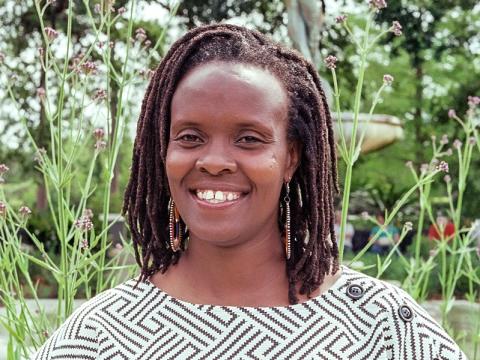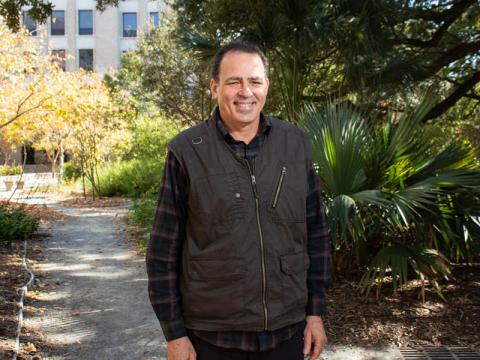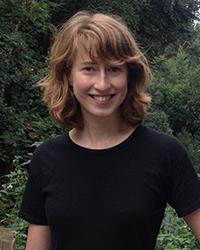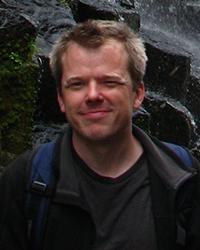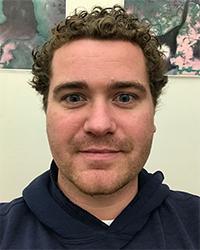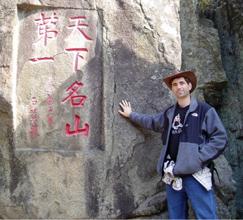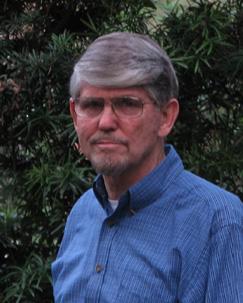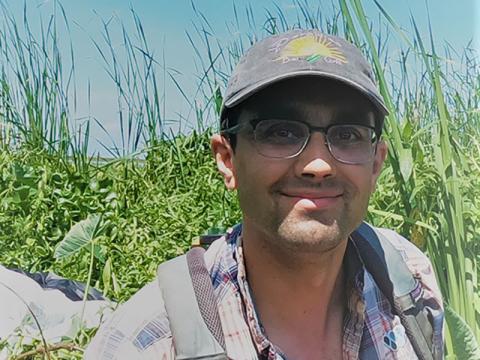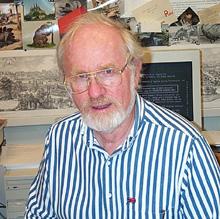Dr. Parsley's research interests include Phylogenetics, functional morphology, paleoecology, and mode and tempo of evolution of Lower Paleozoic primitive Echinodermata; Paleobiology and paleoecology of Lower Paleozoic faunas
Select Publications
Parsley, R. L. and Caster, K. E., 1965, North American Soluta (Carpoidea, Echinodermata), Bull. American Paleontology, Vol. 49, (No. 221), 109- 174.
Hoffmann, H. J., and Parsley, R. L., 1966, Antennae of Ogygopsis, Journal of Paleontology, vol. 40, no. 1, pp. 209-211, 2 figs.
Parsley, R. L., in Caster, K. E., 1968, Family Belemnocystitidae, Treatise on Invertebrate Paleontology Part S, p. 623.
Parsley, R. L.,1970, Revision of the North American Pleurocystitidae (Rhombifera Cystoidea), Bulletin of American Paleontology., vol. 58, no. 260, pp. 135-213, 10 plates, 8 text-figs.
Parsley, R. L., 1972, The Belemnocystitidae: Solutan Homeomorphs of the Anomalocystitidae, Journal of Paleontology vol. 66, no. 3, pp. 341-347, 1 pl., 1 fig.
Parsley, R. L.,1973, Sedimentary Features on the Surface of Mars as Seen from Mariner 6 and 7 Photographs, NASA Contractor Report -CR- 2184, pp. 1-24.
Parsley, R. L.,1975, Systematics and Functional Morphology of Columbocystis, A Middle Ordovician "Cystidean" (Echinodermata) of Uncertain Affinities, Bulletin American Paleontology, vol. 67, Caster Festschrift, pp. 349-361, 1 text-fig., 2 plates.
Parsley, R. L. and Mintz, L., 1975, North American Paracrinoidea: Ordovician: Paracrinozoa, New: Echinodermata), Bulletin of American Paleont., Vol. 68, pp. 1-115, 13 plates, 10 text-figs.
Parsley, R. L.,1978, Thecal Morphology of the Ordovician Paracrinoid Comarocystites (Echinodermata), Journal of Paleontology, vol. 52, no. 2, pp. 472-479, 1 pl., 4 text-figs.
Parsley, R. L., 1980, Homalozoa. In Echinoderms. Broadhead, T. W., and Waters, J. A. (eds.) Univ. of Tennessee, Dept. Geol. Sciences Studies in Geology, 3, pp. 106-117.
Parsley, R. L.,1980, Paracrinoidea, in Echinoderms (op. cit.), pp. 139-143.
Parsley, R. L., 1981, Echinoderms from Middle and Upper Ordovician Rocks of Kentucky, U. S. Geological Survey Professional Paper 1066K, pp. K1-K9, 1 pl., 1 text-fig.
Parsley, R. L., 1982, Paracrinoids, in Echinoderm faunas from the Bromide Formation (Middle Ordovician) of Oklahoma, Univ. of Kansas Paleontological Contributions, Monograph 1, pp. 212-223, pls. 23, 24, text-figs. 58, 59.
Sprinkle, J. and Parsley, R. L., 1982, "Golf Ball" Paracrinoid, Univ. of Kansas Paleontological Contributions, Monograph 1, pp. 224-230, pl. 25, text- fig. 60
Parsley, R. L., 1982, Pleurocystitids, Univ. of Kansas Paleontological Contributions, Monograph 1, pp. 274-279, pl. 34, text-figs. 67, 68.
Parsley, R. L., 1982,Eumophocystis, Univ. of Kansas Paleontological Contributions, Monograph 1, pp. 280-288, pls. 35, 36, text-figs. 69-71.
Parsley, R. L., 1982, Homalozoans, Univ. of Kansas Paleontological Contributions, Monograph 1, pp. 322-323.
Parsley, R. L., 1983, Treatise on Invertebrate Paleontology: Part T, Echinodermata 2, Crinoidea, Review, Journal of Paleontology, vol. 57, no.1, pp. 193-194.
Lewis R., Sprinkle J., Bailey B., Moffit J., and Parsley R., 1987, Mandalacystis, a new rhipidocystid eocrinoid form the Whiterockian stage (Ordovician) in Oklahoma. Journal of Paleontology, 61:6, pp. 1222-1235, 7 figs.
Parsley, R. L.,1988, Probable feeding and respiratory mechanisms in Aristocystites (Diploporida,, Middle-Upper Ordovician of Bohemia, ČSSR). in Burke, R. D. et. al. (eds.), Echinoderm Biology pp. 103-108, 3 text-figs. Proceedings of the 6th International Echinoderm Conference. Balkema, Rotterdam.
Parsley, R. L.,1988, Feeding and respiratory strategies in Stylophora. in, Echinoderm phylogeny and evolutionary biology. Paul, C. R. C. and A.B. Smith, (eds.), pp. 347-361, 8 text-figs., Oxford Science Publications and Liverpool Geological Society, (Current Geological Concepts 1), Clarendon Press, Oxford,
Parsley, R. L., 1989, Latex casting of macroinvertebrate fossils. In Paleontechniques, Feldmann, R. M. et. al. eds., pp. 275-281, Paleontological Soceity, Special publication no. 4.
Parsley, R. L.,1990, Aristocystites a recumbent diploporid (Echinodermata) from the Middle and Upper Ordovician of Bohemia, ČSSR. Jour. of Paleontology, vol. 64: 2, pp. 2798-293.
Parsley, R. L.,1991, Review of Selected North American Mitrate Stylophorans (Homalozoa: Echinodermata). Bulletin of American Paleontology. vol. 100, pp.1- 57, 7 plates, 20 text-figs. Paleontological Research Institution, Itheca, New York.
Gutierrez - Marco, J. C., Melendez, B., Parsley, R. L., Prokop, R. J. and Marek, L. 1992. Equinodermos (Cystoides, Homalozon, Asterozna). De afinidades Bohemicas en el Ordovicico del los zonas centroiberica y ossa Morena, Espania. Publ. Mus. Geol. Estremadura, 1:79-81.
Parsley, R. L.,1994, Mitrocystitid functional morphology, evolution, and their relationships with other primitive classes. In Echinoderms Through Time, David, Bruno, et. al., eds. pp. 167-177, 7 text figs. Balkema Press, Rotterdam
Marek,L., Parsley, R. L., and A. Galle, 1997. Functional morphology of hyoliths based on flumestudies. Vestnik (Bulletin of the Czech Geological Survey), 72:4 p.351-358.
Parsley, R. L., 1997, The echinoderm classes Stylophora and Homoiostelea: non Calcichordata. Paleontological Society Papers, 3, p. 225-248. The Paleontological Society.
Parsley, R. L. (1998) Community setting and functional morphology of Echinosphaerites infaustus (Fistuliporita: Echinodermata) from the Ordovician of Bohemia, the Czech Republic. Vestník (Bulletin of the Czech Geol. Survey), 73:3: 253-265.
Parsley, R. L.,1998, Taxonomic Revision of the Stylophora, in Mooi, R. and M. Telford eds. Echinoderms—San Francisco, p. 111-117. Proceedings of the Ninth International Echinoderm Conference. Belkema Press, Rotterdam .
Parsley, R. L.1999, The Cincta (Homostelea) as Blastozoans In. Carnavali, M.D.C. and F. Bonasoro eds., Echinoderm Research 1998, p. 369-375. Belkema Press, Rotterdam.
Parsley. R. L 2000, Morphological and Paleontological analysis of the Ordovician ankyroid Lagynocystis: (Stylophora: Echinodermata). Journal of Paleontology. 74:2: 254-262.
Parsley, R. L., R. Prokop, and K. Derstler, 2000, Kirkocystid ankyroids (Stylophora: Echinodermata) from the Šárka Formation of Bohemia. Vestnik, (Bull. of the Geol. Survey, Czech Republic), 75:1: 37-45.
David, B; Lefebvre, B.; Mooi, R; and Parsley, R. 2000, Are homalozoans echinoderms? An answer from the extraxial-axial theory. Paleobiology 24:4: 529-555.
Yuan, X., S. Xiao, Parsley, R. L., C. Zhou, Z. Chen, and J. Hu, 2002, Towering sponges in an Early Cambrian Lagerstatte: Disparity between nonbilaterian and bilaterian epifaunal tiers at the Neoproterozoic-Cambrian transition. Geology 30:4: 363-366.
Sumrall, C. D. & Parsley, R. L., 2003, Morphology and biomechanical implications of isolated discocystinid plates (Edrioasteroidea, Echinodermata) from the Carboniferous of North America. Palaeontology, 46 (1) 113-138. (The Palaeontological Association), London.
Parsley, R. L. & R.J. Prokop, 2004, Functional morphology and paleoecology of some sessile Middle Cambrian echinoderms from the Barrandian region of Bohemia. Bulletin of Geosciences 79:3: 147-156
Parsley, R. L., & Y-l Zhao, 2004, Functional morphology of brachioles in gogiid and other Lower and Middle Cambrian eocrinoids. In T. Heinzeller & J. Nibelsick eds. Echinoderms: München: Proc.11th International Echinoderm Conference. Pp. 479- 484. Taylor & Francis, London
Xiao, Shuhai., Jie Hu, Xunlai Yuan, Parsley, R. L., & Ruiji Cao, 2005, Articulated sponges from the Early Cambrian Hetang Formation in southern Anhui, South China: Their age andimplications for the early evolution of sponges. Palaeogeography, Palaeoclimatology,and Palaeoecology 220:89-117, Elsevier .
Galle, A & Parsley, R. L., 2005. Epibiont relationships on hyolithids demonstrated by Devoniantabulates (Anthozoa) and Ordovician trepostomes (Bryozoa). Bulletin of Geosciences. 80:2: 125-138.
Parsley, R.L. & J. C. Gutierrez- Marco 2005. Stylophorans in Middle Arenig shallow water siliciclastics: Vizcainocarpus from the Imfout Syncline in Morocco's western Meseta. Bulletin of Geosciences. 80:3: 185- 192.
Zhao, Y-L, Zhu, M., Babcock, L.E., Yuan, J-L., Parsley, R. L., Peng, J., Yang, Y., and Wang, Y. 2005, Kaili Biota: A taphonomic window on diversification of metazoans from the basal Middle Cambrian:Guizhou, China. Acta Geologica Sinica, 79:6: 751 – 765.
Parsley, R. L. & Zhao, Y. 2006. Long-stemmed eocrinoids in the basal Middle Cambrian Kaili Biota, Taijaing County, Guizhou Province, China. Journal of Paleontology, 80: 6: 1058-1071.
Zhao,Y-L, Parsley, R. L., & Peng, J. 2007. Early Cambrian eocrinoids from Guizhou Province, China, Palaeogeography, Palaeoclimentology, Palaeoecology, 254: 317-327
Parsley, R. L.& C. Sumrall. 2007. New primitive echinoderm genera from the Bois D'Ark Formation: Lower Devonian (Lochkovian) of Coal County, Oklahoma. Journal of Paleontology, 81:6:1486- 1493.
Zhao, Y-L, Parsley, R. L., & Peng,J. 2008 Basal Middle Cambrian short stalked eocrinoidsfrom the Kaili Biota, Taijiang County, Guizhou Province, China. Journal of Paleontology, 82 ( 2): 369-376.
Parsley, R. L. 2009. Morphology, ontogeny and heterochrony in Lower and Middle Cambrian gogiids (Eocrinoidea, Echinodermata) from Guizhou Province, China. Paleontological Journal, 43:11; 1406-1414. Paleontological Institute, Russian Academy of Sciences, Moscow.
Zhao, Y-L, Yuan, J-L, Peng, J, Fu, Q-P, Lin, J-p, Yang, R-D, Parsley, R.L., Yang, X-L, Guo, Q-J, and Tai, T-S. (2009). The Kaili Biota, p. 68-79, (In) Century of the Brilliant Leap [sic] : Paleontology of China. Pp 1-391, Science Press, Beijing. (In Chinese)
Parsley, R. L. & Y. Zhao (2010). A new turban-shaped gogiid eocrinoid from the Kaili Formation, (Kaili Biota), Balang, Jianhe County, Guizhou Province, China. Journal of Paleontology, 84:3:549-553
Zhao, Y., Sumrall, C., Parsley, R. L., and Peng, J. (2010). Kailidiscus, A new plesiomorphic edrioasteroid from the basal Middle Cambrian Kaili Biota of Guizhou Province, China. Journal of Paleontology, 84:(4): 668-680.
James Sprinkle, Ronald L. Parsley, Yuanlong Zhao, and Jin Peng, 2011, Revision of lyracystid eocrinoids from the Middle Cambrian of South China and Western Laurentia, Journal of Paleontology, 85: (2): 250-255
Zhao, Y-L (Editor). 2011. The Kaili Biota: Marine organisms from 508 million years ago. Twenty three authors including R.L. Parsley (individual sections not defined but see p.170-179). Guizhou Publishing Group, 251 pages. (In Chinese).
Parsley, R. L, S. Rozhnov and C. Sumrall. 2012. Morphologic and Systematic revision of the Solute Maennilia estonica (Homoiostelea, Echinodermata) from the Upper Ordovician of Estonia. Journal of Paleontology, 86:3:462-469
Zamura, S, Lefebvre, B., plus 12 authors including Parsley, R. L., Cambrian echinoderm diversity and palaeobiogeography, Geological Society of London. Accepted for publication Sept. 22, 2011.
Parsley, R. L. 2012, Ontogeny, functional morphology, and comparative morphology of lower (Stage 4) an basal Stage 5 Cambrian gogiids , Guizhou Province, China. Journal of Paleontology, 86(4): 569-583.
Parsley, R. L. and Zhao, Y.L. 2012. Gogiid eocrinoids of the Kaili Biota, Guizhou Province, China, in Cryogenian-Ediacarian to Cambrian Stratigraphy and Paleontology of Guizhou, China, in Zhao et al., eds, Journal of Guizhou University (Natural Science) 29 (Supplement 1):16-22.
Zhao, Y., Zhu, M., Peng, J., Yuan, J., Parsley, R. L., Babcock, L. Lin, J-P., Yang, X., Yin, L., Sun,H., and Tai, T. 2012. The Kaili Biota- An informal review commemorating the 30th anniversary of its discovery. in Cryogenian-Ediacarian to Cambrian Stratigraphy and Paleontology of Guizhou, China, Zhao et al., eds. Journal of Guizhou University (Natural Science) 29 (Supplement 1):1-9.
Zhao, Y., Peng, J., Yuan, j., Guo, Q., Tai, T., Yin, L., Parsley, R. L, Yang, Y., Yang, X., and Zhang, P., 2012. The Kaili Formation and Kaili Biota at the Wuliu-Zengjiayan Section of Guizhou Province, China and proposed Global Standard Stratotype Section and Point (GSSP) of the unnamed Cambrian Series 3, Stage 5. In Cryogenian-Ediacarian to Cambrian Stratigraphy and Paleontology of Guizhou, China. Zhao et al., eds, Journal of Guizhou University (Natural Science) 29 (Supplement 1):108-124.
Parsley, R. L. 2012, Development and functional morphology of sutural pores in early and middle Cambrian gogiid eocrinoids from Guizhou Province, China. Echinoderms in a Changing World. Proceedings of the 13th International Echinoderm Conference, University of Tasmania, Hobart, Tasmania. CRC/Balkema Press, Leiden.
